Canada’s second-tallest freestanding structure is now being demolished, but how does one go about tearing down a monolithic chimney that rises as tall as New York City’s Empire State Building?
The enormous Vale Superstack (formerly known as the Inco Superstack) has stood high above the Sudbury skyline since it was completed in 1972, rising a towering 381 metres (1,250 ft) — a height exceeded only by Toronto’s CN Tower among freestanding structures in Canada.
The Superstack — designed to better disperse smelting gas from Vale’s Copper Cliff Complex — has stood as the tallest chimney in the Western Hemisphere throughout its existence.
In its early years, the behemoth held the record for the world’s tallest chimney until 1987, when it was overtaken by the Ekibastuz GRES-2 Power Station in Kazakhstan.
However, Sudbury’s claim to fame (aside from that giant nickel) is now being erased from the record books.
Vale Base Metals’ plan to demolish the stack was first announced in 2024, with the aim to begin dismantling the structure starting this year alongside the already-active removal of the complex’s much shorter Copperstack.
VBM began the arduous task of disassembling the second-tallest structure in the province this spring, and offered up a video preview of just how the complex operation will be carried out over the next few years.
Demolishing one of the tallest structures on the continent is a task you can’t just attack head-on like your standard demolition project. There will be no wrecking balls or implosions here, but, instead, a meticulous disassembly of the enormous chimney.
Preparation to take down the structure has been ongoing for weeks since the spring, including the removal of steel chimney liners and ancillary structures, as well as the installation of work elevators to shuttle demolition crews up and down the enormous concrete chimney.
A platform atop the stack is being used as a base for a drilling machine that will gradually chip away at the concrete from the top down, a process anticipated to begin this August.
Rubble is conveniently dropped down the shaft of the chimney, where it is then carted off-site — all using remotely-operated gear that will allow the job to continue through harsh conditions.
According to an infographic produced by Vale, the stack took two years to build, but its removal will take roughly 2.5 times as long, and is set to stretch five years, from 2025 to 2029.
During this time, a workforce of up to 35 workers (at the dismantling’s peak) will work a staggering 40,000 hours to dismantle the enormous chimney.
While it won’t be a quick or dramatic teardown, the result will have a monumental impact on Sudbury’s skyline.



